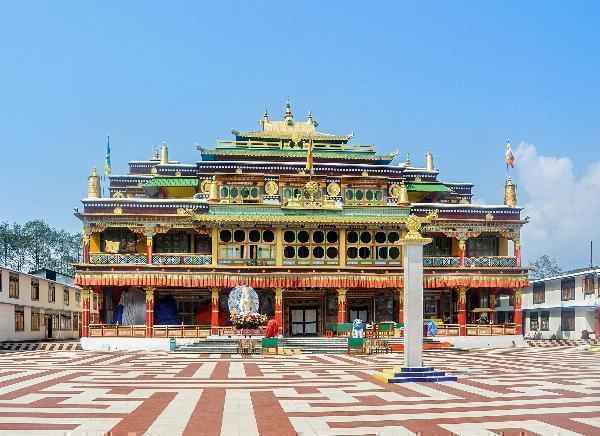Discovering the Spiritual and Cultural Legacy of Ralong Monastery, Sikkim

Strong 8k brings an ultra-HD IPTV experience to your living room and your pocket.
Ralong Monastery, located in the serene hills of South Sikkim. It is a significant spiritual and cultural landmark that attracts visitors from around the world. This monastery, with its rich history and vibrant traditions, offers a glimpse into the religious life and practices of the Buddhist community in Sikkim. Whether you are a spiritual seeker, a history lover or a curious traveler, Ralong Monastery promises a profound and beautiful experience.
Ralong Monastery: An Overview
Ralong Monastery, also known as Ralong Palchen Choling Monastery, is one of the most important monasteries in Sikkim. It belongs to the Karma Kagyu sect of Tibetan Buddhism, which is one of the oldest and most revered schools of Buddhism in the region. The monastery is situated near Ravangla, a small town that is known for its scenic beauty and tranquil ambiance. Surrounded by lush green forests and majestic mountains, Ralong Monastery offers a peaceful retreat for those looking to escape the hustle and bustle of modern life.
The monastery is not just a place of worship; it is also a center for learning and preserving Buddhist teachings and practices. Monks from different parts of Sikkim and neighboring regions come here to study Buddhist scriptures, rituals, and philosophy. The monastery’s serene environment and spiritual aura make it an ideal place for meditation and contemplation.
Ralong Monastery History: A Journey Through Time
The history of Ralong Monastery is deeply intertwined with the religious and cultural history of Sikkim. The monastery was built in 1730 by the fourth Chogyal (king) of Sikkim, Gyurmed Namgyal. According to historical accounts, the Chogyal received the blessings of the 9th Karmapa, Wangchuk Dorje, who is one of the most revered figures in the Karma Kagyu lineage. The establishment of Ralong Monastery was part of the Chogyal’s efforts to strengthen Buddhism in Sikkim and promote the teachings of the Karma Kagyu sect.
One of the most significant events in the history of Ralong Monastery is the introduction of the “Pang Lhabsol” festival. This festival, which is unique to Sikkim, was initiated by the third Chogyal of Sikkim, Chagdor Namgyal, to commemorate the pact of blood brotherhood between the Lepchas (the indigenous people of Sikkim) and the Bhutias (immigrants from Tibet). The festival is celebrated with great fervor at Ralong Monastery, where monks perform traditional masked dances and rituals to honor the mountain deity, Mount Kanchenjunga, and to seek blessings for peace and prosperity.
Over the centuries, Ralong Monastery has undergone several renovations and expansions. In 1940, the monastery was rebuilt by the 12th Gyaltsab Rinpoche after it was damaged by an earthquake. The new structure retained the original architectural style while incorporating modern elements to enhance its durability. Today, Ralong Monastery stands as a testament to the resilience and enduring legacy of Buddhist culture in Sikkim.
Architectural Splendor of Ralong Monastery
The architecture of Ralong Monastery is a harmonious blend of traditional Tibetan and Sikkimese styles. The monastery is adorned with intricate woodwork, colorful frescoes, and ornate carvings that depict various deities, symbols, and scenes from Buddhist mythology. The main prayer hall, known as the “dukhang,” is the heart of the monastery. It houses a magnificent statue of Guru Padmasambhava, the revered Buddhist master who is credited with spreading Buddhism in Tibet and the Himalayan region.
The walls of the prayer hall are lined with thangkas (religious scroll paintings) that depict the life of Buddha, the lineage of the Karmapa, and other important figures in Buddhism. The monastery also has a collection of ancient manuscripts and religious texts that are preserved with great care. These texts are not only valuable religious documents but also important historical records that provide insights into the spiritual and cultural heritage of Sikkim.
The monastery’s courtyard is another highlight, where the monks gather for daily prayers, rituals, and festivals. The courtyard is surrounded by prayer wheels, which are inscribed with the mantra “Om Mani Padme Hum.” Visitors are encouraged to spin the prayer wheels as they walk around the courtyard, a practice believed to accumulate merit and bring peace and blessings.
Spiritual Significance and Festivals at Ralong Monastery
Ralong Monastery is a place of deep spiritual significance for the Buddhist community in Sikkim. It serves as a center for religious education, where young monks receive training in Buddhist philosophy, rituals, and meditation practices. The monastery also plays a vital role in preserving and promoting the rich cultural traditions of the region.
One of the most important festivals celebrated at Ralong Monastery is the “Losoong” festival, which marks the Tibetan New Year. The festival usually takes place in December and is celebrated with great enthusiasm by the monks and the local community. During Losoong, the monastery becomes a hub of activity, with monks performing traditional cham dances (masked dances) that depict the victory of good over evil. The dances are accompanied by the rhythmic beats of drums, cymbals, and horns, creating an atmosphere of joy and celebration.
Another major festival celebrated at Ralong Monastery is “Saga Dawa,” which commemorates the birth, enlightenment, and parinirvana (passing away) of Lord Buddha. Saga Dawa is considered the holiest month in the Tibetan Buddhist calendar, and the monks at Ralong Monastery observe it with prayers, fasting, and religious ceremonies. Devotees from across Sikkim and neighboring regions visit the monastery during this time to offer prayers and seek blessings.
Visiting Ralong Monastery Sikkim: A Journey of Spiritual Discovery
A visit to Ralong Monastery is not just a sightseeing experience; it is a journey of spiritual discovery. The monastery’s tranquil setting, combined with its rich history and vibrant traditions, offers visitors an opportunity to connect with their inner selves and explore the deeper aspects of life.
To reach Ralong Monastery, travelers can take a taxi or bus from Gangtok, the capital of Sikkim, to Ravangla. From Ravangla, it is a short drive to the monastery. The journey to Ralong Monastery is as rewarding as the destination itself, with stunning views of the mountains, forests, and valleys that make Sikkim one of the most beautiful regions in the Himalayas.
Visitors are advised to dress modestly and respect the monastery’s rules and customs. Photography inside the prayer hall is usually not allowed, so it’s important to seek permission from the monks before taking any pictures. The best time to visit Ralong Monastery is during the festivals, when the monastery comes alive with vibrant colors, sounds, and activities. However, even during the quieter months, the monastery offers a peaceful and serene environment that is perfect for meditation and reflection.
Conclusion
Ralong Monastery is more than just a religious site; it is a living testament to the spiritual and cultural heritage of Sikkim. With its rich history, stunning architecture and vibrant traditions, the monastery offers a unique and amazing experience for all who visit. Whether you are drawn to its spiritual significance, its historical legacy, or its architectural beauty, a visit to Ralong Monastery Sikkim is sure to leave a lasting impression on your heart and soul.
Note: IndiBlogHub features both user-submitted and editorial content. We do not verify third-party contributions. Read our Disclaimer and Privacy Policyfor details.


